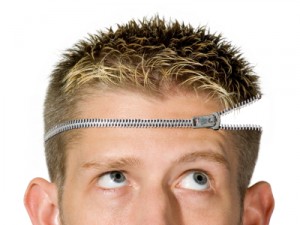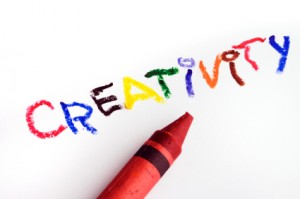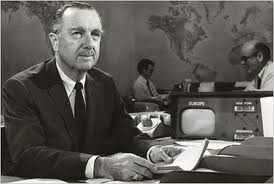Creativity Templates – 2

Pictorial Analogy
A few days ago, I wrote about the study that Jacob Goldenberg et. al. used to demonstrate the effectiveness of creativity templates. Goldenberg and his associates used several different methods to create and test ads. They found that six creativity templates – though not foolproof – consistently created better ads than alternative methods.
So what were the templates? Here they are. (Note: Some of the examples used come from the original article, others come from my experiences).
Template 1 – Pictorial Analogy – uses a picture to exemplify the product (or product attribute) in a compelling way. Two basic versions exist:
Version 1 – Replacement – in illustrating the complexity of warehouse management, we used a picture of a gumball machine filled with different colored gumballs. The picture “replaces” the warehouse and emphasizes the difficulty of getting the right inventory off the shelf and delivered to customers.
Version 2 – Extreme analogy – the picture represents something extreme about the product. For instance, running shoes that cushion the shock might be illustrated with landing gear on a space ship touching down on Mars.
Template 2 – Extreme Situation – creates an unrealistic situation to emphasize key attributes.
Version 1 – Absurd alternative – a security alarm ad shows a woman barking at intruders to scare them away. You don’t have to use our alarm system. You can always learn to bark like a dog – an absurd alternative.
Version 2 – Extreme attribute – exaggerate a product attribute to the absurd. To communicate that a Jeep can go anywhere, show it driving along the bottom of the ocean
Version 3 – Extreme worth – exaggerate the worth of a product feature to the absurd.
Template 3 – Consequences – illustrates the (exaggerated or extreme) consequences of using or not using the product.
Version 1 – Extreme consequences – at a B2B software company, we sent hammocks to a select group of CIOs to give them a place to relax after they bought our software.
Version 2 – Inverted consequences – we also sent straitjackets (real ones – very creepy) to another group of CIOs to show them how they would feel if they didn’t buy our software. Note: the straitjackets worked better.
Template 4 – Competition – the product (or attribute) is shown competing with a product from a completely different class
Version 1 – Attribute in competition – to illustrate the speed of a car, show it racing a bullet.
Version 2 – Worth in competition – not how it performs (speed) but how much it’s worth to you
Version 3 – Uncommon use – a young couple’s car breaks down. A friend offers to tow them but doesn’t have a towrope. They use the husband’s jeans as a towrope. An uncommon use that illustrates the product’s toughness.
Template 5 – Interactive Experiment – invites the viewer into an experiment which demonstrates the need for the product or service
Version 1 – Activation version – you actually engage in the experiment. For instance, you’re invited to scratch your head over a black patch in a magazine. If white flakes appear on the black patch, you need our dandruff shampoo
Version 2 – Imaginary experiment – well, imagine this …
Template 6 – Dimensionality Alteration — change the relationship between the product attribute and the environment.
Version 1 – New parameter – change an attribute in the environment to accentuate the product attribute. To accentuate the color of a shirt, create a photo in which everything is in black-and-white except the shirt.
Version 2 – Multiplication – multiply the product (or product attribute) and then compare it to something in the environment. Example: early Hyundai ads, where two Hyundais cost less than one entry-level Toyota.
Version 3 – Division – divide the product into component parts and compare them to each other and/or to the environment.
Version 4 – Time leap – present an ordinary scenario but make it interesting by shifting it to the past or future. A wife argues with her husband about why he cancelled the life insurance. Sounds ordinary, until you realize that it’s set in the future, when the husband is already dead.
Do these templates always work? Well…. no. But I can attest that they are more efficient and effective than classic brainstorming techniques where no answer is wrong and we throw everything on the white board to see what sticks. Go ahead, give ’em a try.
Creativity Templates – 1
 I’m pretty good at leading brainstorming sessions. I can get people involved, gin up the excitement, and lead a rollicking session. They’re a lot of fun. But are they productive?
I’m pretty good at leading brainstorming sessions. I can get people involved, gin up the excitement, and lead a rollicking session. They’re a lot of fun. But are they productive?
Traditional brainstorming techniques derive from the concepts of free association and divergent thinking which, as Wikipedia notes, “… is a thought process used to generate creative ideas by exploring many possible solutions.” By exploring many different options, we may come up with something useful.
At the very least, it sounds inefficient – like the random programming of computers. Indeed, I rarely find useful ideas in traditional brainstorming sessions. A session may generate a lot of ideas but many of them of them are either trite or just plain silly.
So I was pleased to find a set of “creativity templates” in an article published in 1999 by Jacob Goldenburg, David Mazursky, and Sorin Solomon of the Jerusalem Scool of Business Administration.
The article investigates high quality advertisements. Do they have common features (templates) and can we use those commonalities to create better ads? The authors studied 200 award-winning ads and identified six basic templates (and several sub-templates). The researchers then compared the award-winning ads (let’s call it Group 1) to two other groups:
- Group 2 — 200 ads that had been selected for The One Show Album, a book of well-respected ads. Though selected for the album, these ads had not won other awards.
- Group 3 – 200 ads selected from the same publications and the same product categories as Groups 1 and 2, but that had not been selected for a collection and had not won awards.
Independent judges could classify 89% of the Group 1 ads into one of the six templates. Of the Group 2 ads, 50% used one of the templates. In Group 3, only 2.5% of the ads used one of the templates. So, the templates correlate to higher quality ads.
The researchers then tested whether their insights could be used to create new ads. They established three separate “creative teams” and asked each to create ads for fictional products. The teams were:
- Team 1 – “… was requested to generate ads based only on a brief (without additional training)…”
- Team 2 – received the same briefs as Team 1 but was also taught classic brainstorming techniques, including free association, before generating ads.
- Team 3 – also received the same briefs but was trained to use the creativity templates before generating ads.
Twenty participants were randomly assigned to the three teams and received the designated training. Each group then generated ads for several product categories.
The ads thus produced were then randomized and evaluated in a number of ways. The researchers recruited judges who did not know the objectives of the study and who used well-established criteria for advertising quality.
The findings were quite straightforward. “First, ‘template training’ was found to be superior to ‘no training’ and ‘free association” training and in all the comparisons pertaining to … ad quality measures. … In all cases, template training was superior to training in free association.”
Additionally, the research cast doubt on the efficacy of the free association method used by Team 2. “No clear indication was found that the free association method heightens creativity or brand attitude.” In other words, my frustration with brainstorming may well be justified – it doesn’t increase creativity.
So what are the six templates? We’ll get to that tomorrow. Stay tuned.
Bananas, Bagels, and Inattentional Blindness

Did I eat that?
Can you eat a banana without being aware of it?
On Mondays, Suellen and I go to an early morning exercise class at the University of Denver. Afterwards, we always go to the local bagel shop, have a couple of bagels, and do the New York Times crossword puzzle. (Monday is the easy day for the puzzle. They get harder throughout the week. Sunday is impossible.)
This morning we bought our pair of bagels and Suellen decided to add a banana to our standard fare. We then sat down and began to eat while also working on the crossword puzzle. I was working hard on my bagel and the puzzle. I thought Suellen was, too.
Some ten minutes later, Suellen held up the empty banana peel, looked at me, and asked, “Did I eat this?” Apparently she had though neither of us remembered it. We looked at the tables around us and couldn’t identify anyone who might have stolen the banana and left only the peel. It must have been the Freckled Beauty.
So, does this mean we’re senile? Hardly. It’s a good example, however, of inattentional blindness, something I’ve written about before. When you’re concentrating on something, a lot of other things can slip right past you. It’s a good reason to be suspicious of eyewitnesses and your own memory.
Personal Branding In The Social Media Age

How’s my brand?
When I was a teenager, my mother urged me to dress nicely because, “you do want to make a good impression, don’t you?” She even taught me how to iron my clothes so I could make a neatly pressed impression. (In fact, “pressing” clothes and making an “impression” derive from the same root). I remember asking her, “If it’s so important to make a good impression, why don’t you iron my clothes?” She answered with a smile: “It’s not that important”.
Mom also told me (repeatedly) that “you have only one chance to make a first impression.” She didn’t know it but she was speaking the language of personal branding. I’m often asked what personal branding means and I simply shrug and say, “it’s the impression you make”. We all make an impression on others, whether we intend to or not, and that impression is essentially our brand.
Another popular definition is that your personal brand is what other people say about you when you’re not around. Actually, I would distinguish between two different commentaries. When you’re not around, people can talk about what you do or who you are. The what-you-do stories are often interesting (“Did you hear what Travis did?”) but they’re not really your brand. Your brand consists of the who-you-are comments.
While the what-you-do stories can be lengthy, the who-you-are commentaries are usually quite brief – typically, 25 words or less. So your brand consists of the roughly 25 words that people speak about you when you’re not around. (This is a pretty good definition of a corporate brand as well).
If you care about your brand (some people don’t), you need to think about how to get the right words in place. My mother called it making an impression; today we call it managing your brand. But, really it’s the same thing. How do you get people to think of you in the way you want to be thought of?
One big difference between my mom’s era and today is the arrival of social media. In my mom’s day, making an impression typically meant meeting somebody face-to-face. Or it might have meant a good cover letter and resumé. (Mom was a great copy editor). Either way, it was personal.
Today, it’s not so personal. I can make a first impression on someone I’ve never met and never even heard of. Recruiters might look me up on LinkedIn. Friends of friends might see my Facebook page. Indeed, I hope that lots of people I don’t know will come to my website.
The other big difference from my mom’s era is the economy. My mother grew up in a manufacturing economy, where your skills were important. We’re now in a service economy, where your personality is important. As Tony Tulathimutte points out in The New Yorker, “Success in a service job … often involves getting people to see you as competent and likeable. … Now that what we have to offer in the service economy is ourselves, the rules of branding apply to us.”
So how do you make a good first impression these days? Think about the 25 words you want people to say about you and then work backwards. If you want people to say you’re intelligent, you better learn to write (and spell) well. If you want people to say you’re a good manager, then highlight your management expertise. As my mother used to say, “just remember to put your best foot forward”. Oh, and learn how to iron
